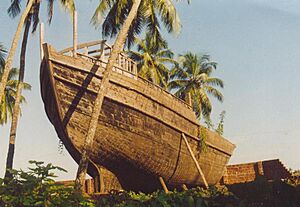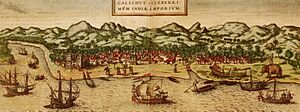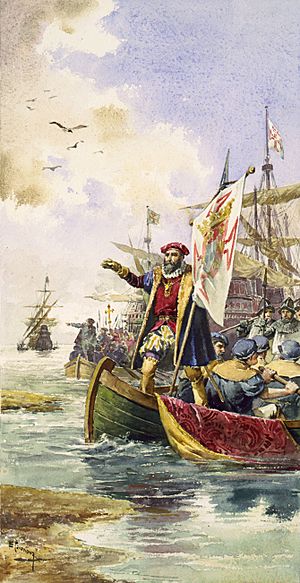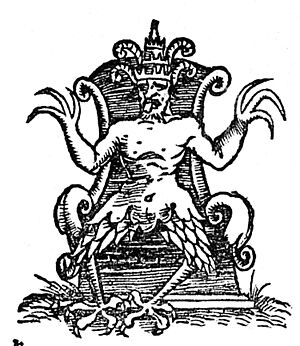Calicut (kingdom) facts for kids
Quick facts for kids
Kingdom of Calicut
|
|||||||||
|---|---|---|---|---|---|---|---|---|---|
| 1124–1806 | |||||||||
 |
|||||||||
| Status | Kingdom | ||||||||
| Capital | Calicut | ||||||||
| Common languages | Malayalam | ||||||||
| Religion | Hinduism | ||||||||
| Government | Feudal Monarchy | ||||||||
| Zamorin | |||||||||
|
• 1124-1132
|
Mana Vikrama | ||||||||
|
• 1798-1806
|
Krishna Varma | ||||||||
| History | |||||||||
|
• Dissolution of the Cheras of Cranganore
|
1124 | ||||||||
|
• Mysorean invasion of Malabar
|
1766-1792 | ||||||||
| 1806 | |||||||||
| Currency | Kozhikode Panam | ||||||||
|
|||||||||
| Today part of | India | ||||||||
The Kingdom of Kozhikode (also known as Calicut) was an important kingdom in the area that is now Kerala, India. It was ruled by a king called the Zamorin of Calicut. Today, Kozhikode is the second largest city in Kerala.
Calicut was often called the "City of Spices." This is because it was a major trading hub for spices from the East during the Middle Ages. Its port was the most important on the Kerala coast. Traders from places like Persia, Arabia, China, and Europe came here.
Contents
How the Kingdom Started

Long ago, around the 1st century CE, there was an ancient port called Tyndis near where Calicut is now. It was a big trading center between the Chera kingdom and the Roman Empire. The area around Calicut was part of the Chera Empire. The Cheras ruled this land until about 1102 CE.
Calicut became a major trading city around the 13th century. The Zamorin of Calicut was originally the ruler of a smaller area called Eranad. His main base was in Nediyiruppu. The rulers of Eranad were known as Eradis. They wanted access to the sea for trade. So, they fought a long war against the Porlatiri, who ruled the coastal area of Polanad. The Eradis won this war.
After their victory, the Eradis moved their main base to Calicut. They built a fort there to protect their new port. This is how the city of Calicut began to grow. The king's title slowly changed to Samoothirippadu or Saamoothiri. Europeans later called him the Zamorin.
Some historians believe that the last Chera king, Rama Varma Kulashekhara, gave a small piece of land on the coast to Mana Vikrama. Mana Vikrama was the Governor of Eranad and a favorite of the king. This land later became Calicut.
By the 14th century, Calicut had become very powerful. It took control of parts of central Kerala from the Cochin kingdom. The ruler of Cochin had to move his capital further south. By the 15th century, Cochin became a smaller state under Calicut. This made Calicut the strongest kingdom on the medieval Malabar Coast.
The history of Calicut includes several important events:
- The city's founding.
- The arrival of the Portuguese.
- The arrival of the Dutch.
- The Mysorean invasions.
- The rise of British power.
- The start of the Indian Independence Movement.
- Finally, India's freedom from British rule in 1947.
Life in Calicut
A Chinese traveler named Ma Huan visited Calicut in the 1400s. He wrote that people of different religions, like Hindus and Muslims, lived together peacefully. He noted that the Hindu king even agreed not to eat pork, out of respect for the Muslim people. In return, the Muslims did not eat beef.
Ma Huan also described a detailed system for measuring goods during trade. He observed that the king's sister's son inherited the throne. This was because they believed that only children born from a woman within the royal family were truly part of the family. If there was no such heir, a worthy man would become king.
Portuguese Arrival
A big change happened in Kerala and India when the Portuguese arrived. Vasco da Gama landed in Calicut at Kappad on May 17, 1498. While other groups like the Chinese and Arabs already traded with India, the Portuguese wanted political power and control.
Vasco da Gama was welcomed, but his meeting with the Zamorin did not go well. The Zamorin insisted that da Gama pay customs duties like any other trader. This caused tension.
The next Portuguese expedition came in 1500, led by Pedro Álvares Cabral. They managed to set up a trading post in Calicut. However, this led to fights between the Arabs and the Portuguese. The Portuguese attacked Arab ships, and in return, locals burned down the Portuguese trading post. Cabral then sailed to Cochin, where he was welcomed.
Vasco da Gama returned to Calicut in 1502 with many ships and men. He demanded that all Muslims be expelled from Calicut. When the Zamorin refused, da Gama attacked the city.
The Portuguese then supported Cochin and Cannanore against the Zamorin. Many wars followed from 1503 to the 1570s. In 1509, the Portuguese defeated a combined fleet of several kingdoms in the Battle of Diu. This marked the start of Portuguese control over the spice trade in the Indian Ocean.

In 1509, Afonso de Albuquerque became the second Portuguese Viceroy in the East. He was ordered to destroy Calicut's power. The Zamorin's palace was captured and burned. However, the Zamorin's forces fought back, killing the Portuguese leader and wounding Albuquerque.
Albuquerque later made a peace treaty with the Zamorin in 1513. But fighting started again when the Portuguese tried to harm the Zamorin. From the 1520s, the Zamorin's navy was led by the Kunjali Marakkars. They caused a lot of damage to Portuguese property until 1589. The Zamorin had important ministers, including the Chief Minister, Army Chief, Finance Minister, and the Chief of Naval Force (Kunjali Marakars).
In 1503, the Portuguese built a fort in Chaliyam. This fort allowed them to bother the Zamorin and enter his kingdom easily. The Zamorin attacked Chaliyam and took back the fort in 1571. The Portuguese had to leave, and the fort was completely destroyed. This event was a major setback for the Portuguese in the East.
By 1663, the Portuguese lost their power in Kerala. The Dutch arrived and took over all their strongholds.
Dutch Arrival
In 1602, the Zamorin invited the Dutch to Calicut, promising them a fort if they traded there. In November 1604, a Dutch fleet arrived. This was the start of the Dutch presence in Kerala. They signed a treaty with Calicut on November 11, 1604. This was the first treaty the Dutch East India Company made with an Indian ruler.
The treaty created an alliance between the Zamorin and the Dutch to remove the Portuguese from Malabar. In return, the Dutch East India Company received trading facilities and large storage houses in Calicut and Ponnani.
However, the Dutch became weaker in the 18th century. They had to surrender to the British in 1795. The kingdom of Travancore became the most powerful state in Kerala after defeating the Zamorin in 1755.
Mysore Invasions
Hyder Ali became the ruler of Mysore in 1761. In 1766, he marched into northern Kerala and easily entered Calicut. The Zamorin sent his family away, blew up his palace, and took his own life to avoid being captured.
A rebellion soon broke out against Mysore. Hyder Ali returned to crush it, causing much destruction. He had to leave to deal with another threat, and the rebellion started again. Hyder Ali then tried diplomacy and agreed to leave if he was paid.
But he returned in 1773 and took control of Malabar again. Later, with British help, the Nairs, led by Ravi Varma of Padinjare Kovilakam, drove out the Mysorean forces from Calicut by 1778.
By 1783, Tipu Sultan, Hyder Ali's son, took control of Northern Kerala. He even planned to move the capital from Calicut to a new city called 'Farookhabad' (now Feroke). This plan failed.
In 1788, Calicut was attacked by the Nairs again. Tipu Sultan returned in 1789 to regain control. This led to conflicts with the British in Madras. Calicut and nearby areas were given to the British after the Third Anglo-Mysore War in 1792. These areas became the Malabar District of the Madras Presidency, with Calicut as its capital.
British Rule
The British arrived in Kerala in 1615. They signed a trade treaty with Calicut. The British were supposed to help Calicut against the Portuguese, but they never did. In 1664, the Zamorin allowed the English to build a trading post in Calicut. However, he became suspicious of all European traders.
The British stayed neutral during the Mysore invasions in 1766, which helped Hyder Ali. But tensions soon grew between the British and Mysore. The British army helped Ravi Varma of Padinjare Kovilakam take back Calicut from Mysore in 1782.
By 1792, all of Malabar, including Calicut, came under British rule. Ravi Varma then turned against the British but was captured in 1793. The rebellion continued until 1797. Under the British Raj, Calicut was the headquarters of the Malabar District. This area was important for producing pepper.
Calicut became the first modern municipality in Kerala on November 1, 1866.
Fight for Freedom
The city of Calicut played a role in India's struggle for independence from the British. In 1904, a meeting of the Congress party was held there. A local branch of the Indian Home Rule Movement also started in the city.
In 1916, a leader named K.P.Kesava Menon walked out of a meeting because he was not allowed to speak in Malayalam. This period also saw the rise of political newspapers like Mathrubhumi (started in 1923) and Al Amin (started in 1924). These papers aimed to encourage a sense of nationalism.
On May 12, 1930, people gathered at Calicut beach to protest the 'Salt laws' under the leadership of Muhammad Abdur Rahiman. The police attacked them, injuring many. During the Second Civil Disobedience Movement in 1932, many delegates at a conference in Calicut were arrested. An incident where a woman was forced to give up her gold ornaments, including her tali (a traditional necklace), caused widespread anger.
Calicut was also a key center for the rising Communist Party of Malabar (formed in 1939) and the Quit India Movement (1942).
After India gained independence in 1947, the Madras Presidency was renamed the Madras State. In 1956, when Indian states were reorganized based on language, the Malabar District joined with Travancore-Cochin to form the new state of Kerala. On January 1, 1957, the Malabar District was split into three new districts: Kannur, Kozhikode, and Palakkad. Kozhikode became a Municipal Corporation in 1962, making it the second oldest in the state.
See also




